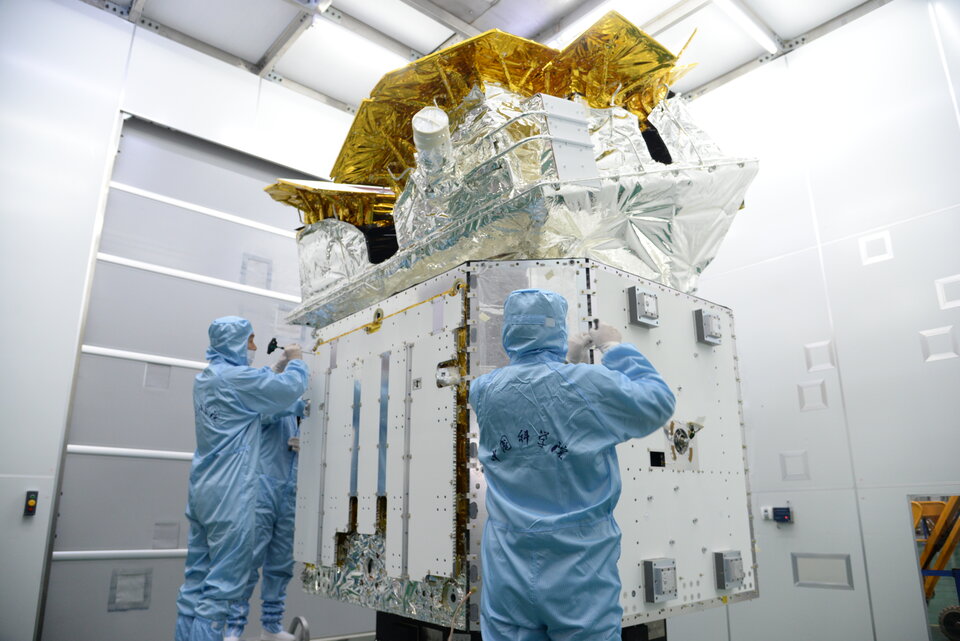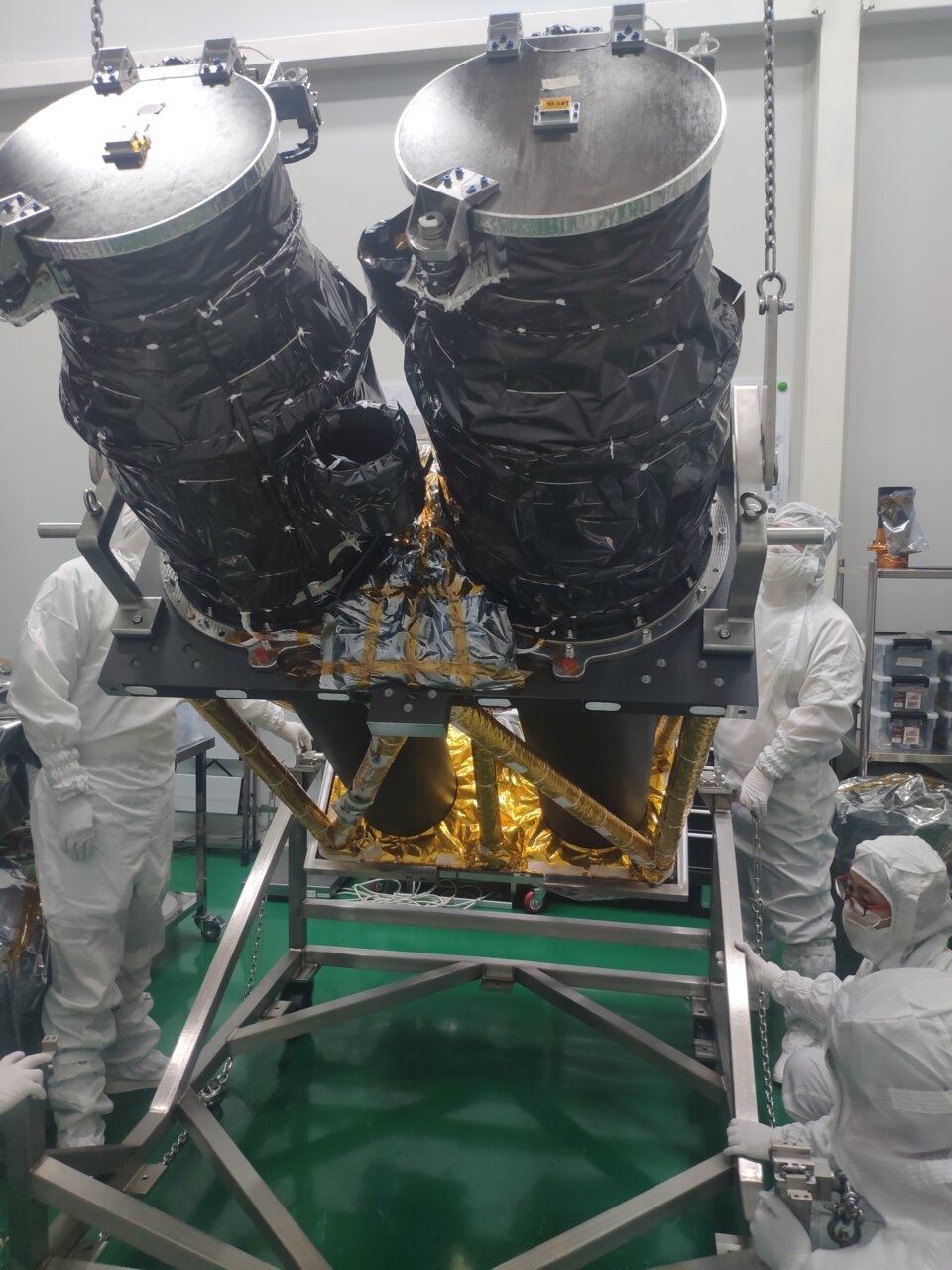23.12.2023
Innovative X-ray lobster-eye mission set to launch

The Chinese Academy of Sciences (CAS) spacecraft Einstein Probe is ready to launch in January 2024. Equipped with a new generation of X-ray instruments with high sensitivity and a very wide view, this mission will survey the sky and hunt for powerful blasts of X-ray light coming from mysterious celestial objects such as neutron stars and black holes.
Einstein Probe is a collaboration led by CAS with the European Space Agency (ESA) and the Max Planck Institute for Extraterrestrial Physics (MPE), Germany.
In return for contributing to the development of this mission and the definition of its scientific goals, ESA will get access to 10% of the data generated by Einstein Probe’s observations.
“Thanks to its innovative design, Einstein Probe can monitor large swaths of the sky at a glance. In this way we can discover many new sources while at the same time study the behaviour of X-ray light coming from known celestial objects over long periods,” says Erik Kuulkers, ESA’s Einstein Probe Project Scientist. “The cosmos is our only laboratory to investigate the most energetic processes. Missions like Einstein Probe are essential to advance our understanding of these processes and to learn more about fundamental aspects of high-energy physics.”

Keeping a watchful eye on the X-ray sky
Unlike the stars that dot our sky at night and reliably mark the constellations, most cosmic objects that shine in X-rays are highly variable. They are continuously brightening and dimming, and in many cases, they briefly appear before they disappear for long periods (then they’re called transient) or for good.
Powered by tumultuous cosmic events, X-ray light from astronomical sources is very unpredictable. Yet, it carries fundamental information about some of the most enigmatic objects and phenomena in our Universe. X-rays are associated with collisions between neutron stars, supernova explosions, matter falling onto black holes or hyper-dense stars, or high-energy particles being spewed out from discs of blazing material circling such exotic and mysterious objects.
Einstein Probe will improve our understanding of these cosmic events by discovering new sources and monitoring the variability of objects shining in X-rays all over the sky.
The capability of routinely spotting new X-ray sources is fundamental to advance our understanding of the origin of gravitational waves. When two hyper-dense massive objects such as two neutron stars or black holes crash, they create waves in the fabric of spacetime that travel over cosmic distances and reach us. Several detectors on Earth are now able to register this signal, but often cannot locate the source. If neutron stars are involved, such a ‘cosmic crash’ is accompanied by an enormous burst of energy across the light spectrum, and especially in X-rays. By enabling scientists to promptly study these short-lived events, Einstein Probe will help us identify the origin of many of the gravitational wave impulses that are being observed on Earth.
Lobster eyes in space

To achieve all of its scientific goals, the Einstein Probe spacecraft is equipped with a new generation of instruments with high sensitivity and the ability to observe large areas of the sky: the Wide-field X-ray Telescope (WXT) and the Follow-up X-ray Telescope (FXT).
WXT has an optical modular design that mimics the eyes of a lobster and uses innovative Micro Pore Optics technology. This enables the instrument to observe 3600 square degrees (nearly one-tenth of the celestial sphere) in one shot. Thanks to this unique capability, Einstein Probe can keep a watchful eye on almost the entire night sky in three orbits around Earth (each orbit taking 96 minutes).
New X-ray sources or other interesting events spotted by WXT are then targeted and studied in detail with the more sensitive FXT. Crucially, the spacecraft will also transmit an alert signal to the ground to trigger other telescopes on Earth and in space operating at other wavelengths (from radio to gamma-rays). They will swiftly point to the new source to collect precious multi-wavelength data, thus enabling a more thorough study of the event.
European contribution

ESA has played an important role in developing Einstein Probe’s scientific instrumentation. It provided support for testing and calibrating the X-ray detectors and the optics of WXT. ESA developed the mirror assembly of one of FXT’s two telescopes in collaboration with MPE and Media Lario (Italy).
The FXT mirror assembly is based on the design and technology of the ESA’s XMM-Newton mission and the eROSITA X-ray telescope. MPE contributed the mirror assembly for the other telescope of FXT and developed the detector modules for both FXT’s units. ESA also provided the system to deflect unwanted electrons away from the detectors (the electron diverter).
Throughout the mission, ESA’s ground stations will be used to help download the data from the spacecraft.
ESA’s fleet of high-energy missions
ESA has a long history of advancing high-energy astronomy. XMM-Newton and Integral have been scrutinising the Universe in X-rays and gamma-rays for over two decades leading to great progress in this field. ESA is also taking part in the X-Ray Imaging and Spectroscopy Mission (XRISM), led by the Japan Aerospace Exploration Agency (JAXA) in collaboration with NASA, which launched in summer 2023.
“Einstein Probe’s capabilities are highly complementary to the in-depth studies of individual cosmic sources enabled by the other missions,” remarks Erik. “This X-ray surveyor is also the ideal precursor to ESA’s NewAthena mission, currently under study and set to be the largest X-ray observatory ever built.”
Quelle: ESA
